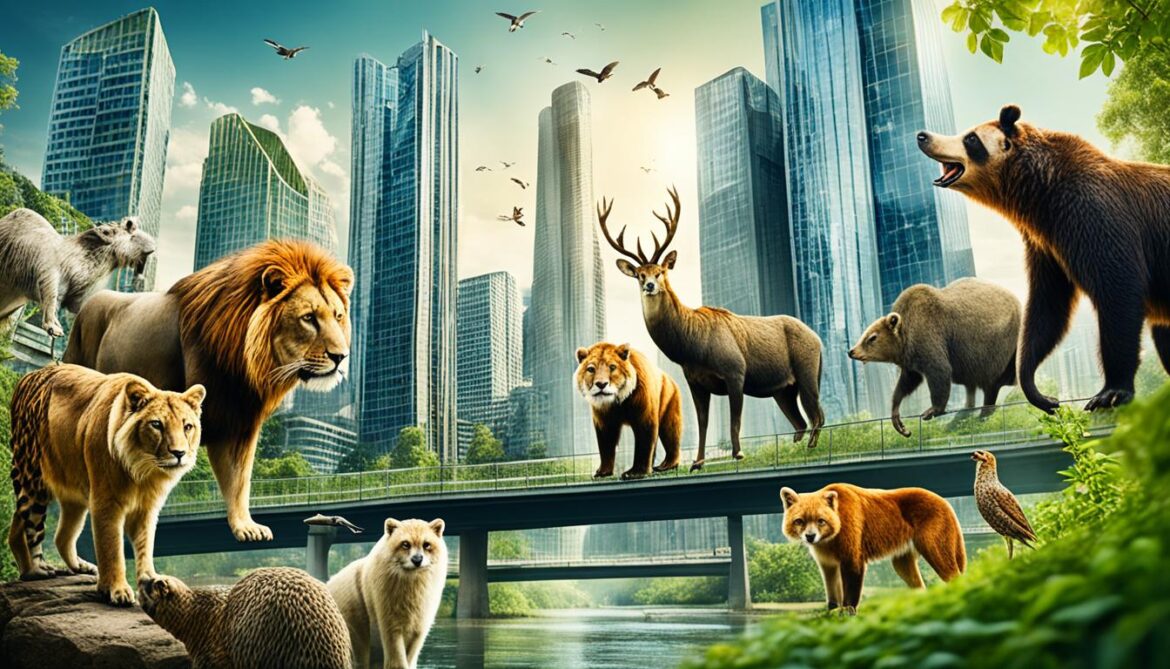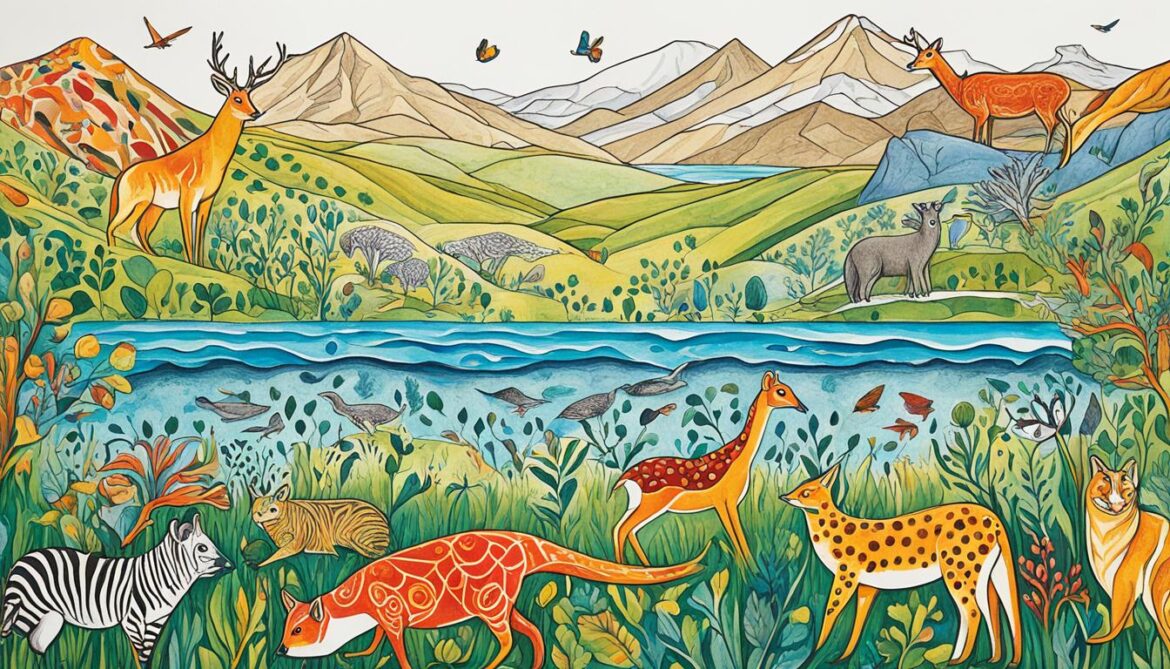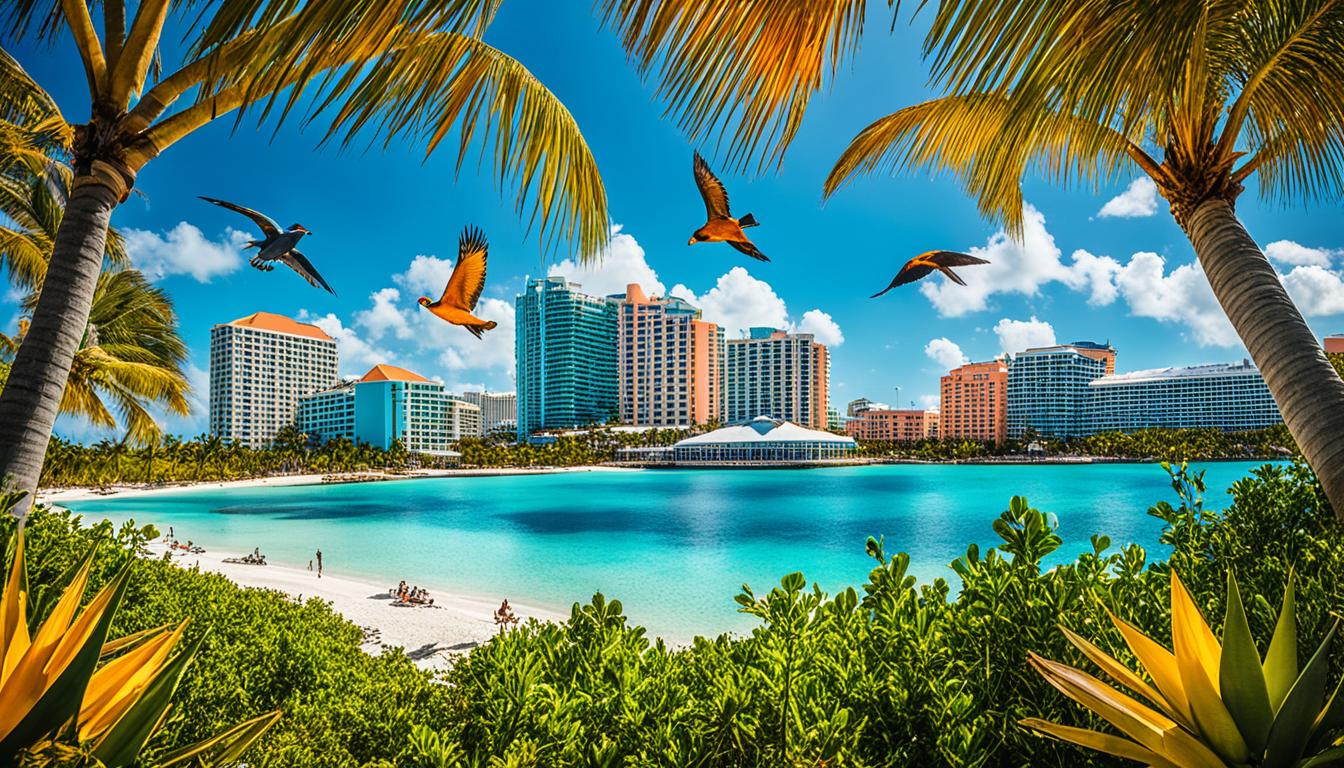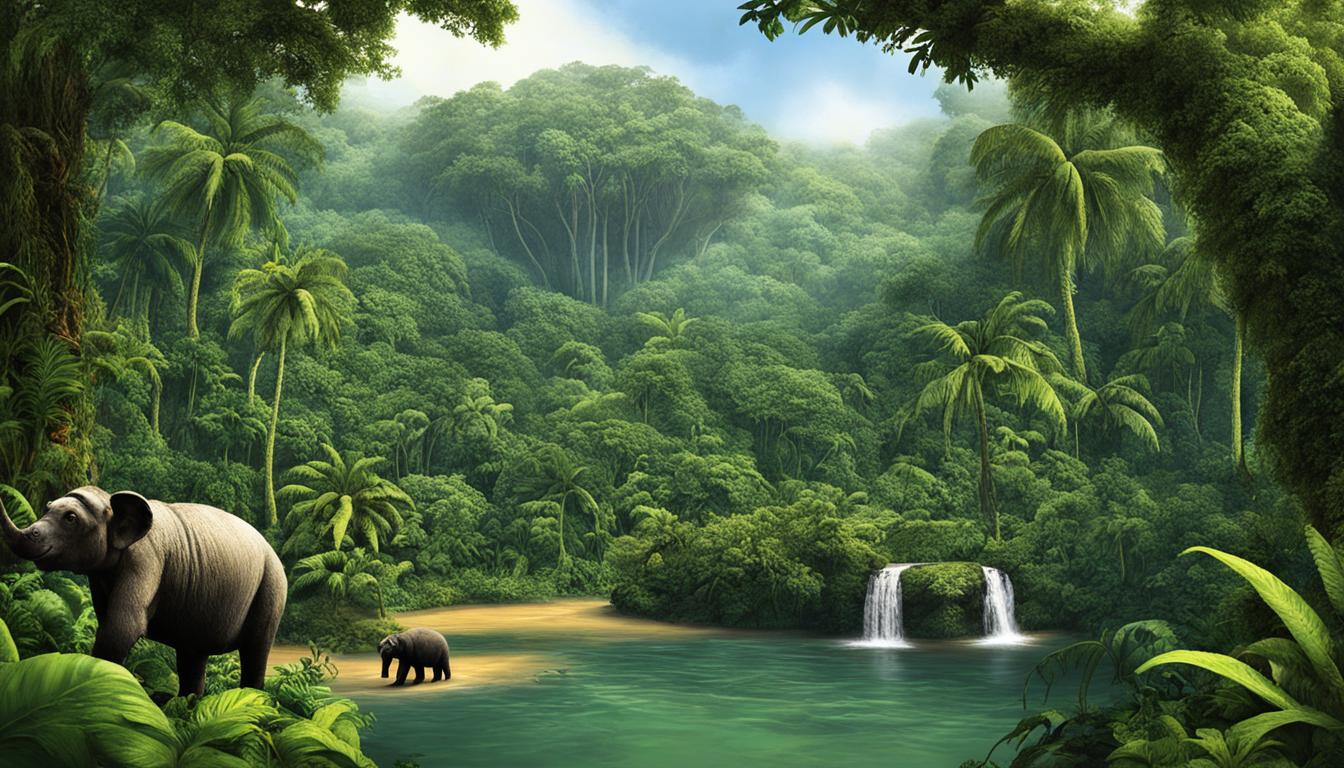Azerbaijan Biodiversity and the Built Environment
Azerbaijan is renowned for its incredible biodiversity, which thrives in both its natural habitats and urban environments. The country’s unique geography and diverse ecosystems make it a biodiversity hotspot, boasting a wide range of animal and plant species. In this article, we will explore Azerbaijan’s remarkable biodiversity, the importance of sustainable urban development, and the efforts being made to conserve and protect its natural heritage.
Key Takeaways
- Azerbaijan is a biodiversity hotspot, home to a wide range of animal and plant species.
- Sustainable urban development is crucial for preserving biodiversity in urban environments.
- Conservation efforts, including green infrastructure and urban planning, play a vital role in protecting Azerbaijan’s natural habitats.
- Azerbaijan’s unique ecosystems, such as the Greater and Lesser Caucasus mountain ranges and the Caspian Sea coastline, contribute to its exceptional biodiversity.
- Efforts are being made to conserve endangered species and promote sustainable land management practices in Azerbaijan.
The Rich Ecosystems of Azerbaijan
Azerbaijan is blessed with diverse ecosystems, spanning from majestic mountains and lush valleys to picturesque coastal areas. The country’s unique geographical features, including the Greater and Lesser Caucasus mountain ranges and the Caspian Sea coastline, contribute to its exceptional ecological richness.
These areas have been identified as significant biodiversity hotspots and Global 200 Ecoregions, recognizing their exceptional species richness and endemism. Each ecoregion in Azerbaijan offers distinct habitats and supports a wide array of plant and animal life.
The Greater Caucasus mountain range runs across northern Azerbaijan, forming a natural barrier that influences climatic conditions and species distribution. Its towering peaks and deep valleys create diverse microclimates that harbor unique plant and animal species.
The Lesser Caucasus mountain range, located in the southern part of the country, also contributes to Azerbaijan’s rich biodiversity. This mountainous region is home to a variety of ecosystems, including alpine meadows, mixed forests, and subalpine grasslands.
The Caspian Sea coastline further enhances Azerbaijan’s ecological diversity. This coastal zone is characterized by wetlands, marshes, and sandy beaches, providing habitat for numerous plant and animal species that have adapted to the marine and littoral environments. The Caspian Sea is also known for its valuable fish resources.
The rich ecosystems of Azerbaijan support high levels of species richness, with a remarkable variety of flora and fauna. The country’s wealth of endemic species, those found nowhere else in the world, showcases the significance of Azerbaijan’s biodiversity.
| Ecoregion | Unique Habitats | Key Species |
|---|---|---|
| Mediterranean Dry-Hot Summer Forests | Deciduous forests, shrublands | Georgian Hazel, Persian Oak |
| Anatolian-Iranian Highland Meadow | Alpine meadows, subalpine grasslands | Persian Onobrychis, Caucasian dragonhead |
| North Caspian Hyrcanian Mixed Forests | Deciduous broadleaf forests, temperate rainforests | Persian Ironwood, East Caucasian Silver Birch |
These biodiversity hotspots and Global 200 Ecoregions in Azerbaijan demonstrate the country’s commitment to preserving its natural heritage. Conservation efforts focused on protecting these diverse ecosystems and their endemic species are crucial for the long-term survival of Azerbaijan’s rich biodiversity.
Efforts for Wildlife Conservation in Azerbaijan
Azerbaijan is committed to wildlife conservation and has taken significant steps to protect its natural resources and biodiversity. The establishment of protected areas, including national parks and nature reserves, serves as a crucial method to safeguard key habitats and preserve endangered species. These conservation areas play a vital role in maintaining biodiversity hotspots and providing a safe haven for wildlife.
Sustainable forestry practices and agricultural land management are also integral components of wildlife conservation efforts in Azerbaijan. By promoting sustainable forestry practices, the country ensures responsible management of forest resources while preserving the habitats of various plant and animal species. Similarly, sustainable agricultural land management practices minimize the negative impact of farming activities on wildlife and their habitats, thereby contributing to long-term ecosystem health and sustainability.
To illustrate Azerbaijan’s commitment to wildlife conservation, the following table highlights some of the protected areas and their features:
| Protected Area | Type | Key Features |
|---|---|---|
| Göygöl National Park | National Park | Home to diverse flora and fauna, including the endangered Caucasian leopard |
| Shirvan National Park | National Park | Important habitat for migratory birds and endangered species like the Caspian seal |
| Bash Dashagil State Reserve | Nature Reserve | Protects high-altitude forests and rare plant species |
| Bazarduzu State Reserve | Nature Reserve | Preserves alpine and subalpine ecosystems and supports endangered species |
These protected areas, along with others not mentioned in the table, play a pivotal role in conserving Azerbaijan’s wildlife and their habitats. Additionally, efforts are directed towards creating corridors between these protected areas to facilitate the movement of animals and enhance genetic diversity.
By implementing comprehensive wildlife conservation strategies, Azerbaijan aims to ensure the long-term sustainability of its natural resources, protect endangered species, and preserve the country’s rich biodiversity for future generations.

Unique Animal Species in Azerbaijan
Azerbaijan is home to several magnificent and distinctive animal species, some of which are considered endangered and in urgent need of conservation efforts. These unique creatures contribute to the country’s biodiversity and are an integral part of its ecological tapestry.
The Caspian Seal: One such remarkable species is the Caspian Seal (Phoca caspica). Found exclusively in the Caspian Sea, this marine mammal is facing significant threats due to habitat loss and pollution. With its distinctive features and vital role within the ecosystem, the conservation of this stunning creature has become a priority.
The Albanian Astragalus: Another unique mammal found in Azerbaijan is the Albanian Astragalus (Astragalus fragilis). This plant-eating mammal, endemic to the Caucasus region, is considered endangered due to various factors, including habitat degradation and human activities. Efforts are underway to preserve its habitat and ensure its survival for future generations.
Azerbaijan is also renowned for its diverse bird species, including several that are endemic to the Caucasus region. These endemic bird species not only captivate bird enthusiasts but also serve as indicators of the region’s rich biodiversity and uniqueness.
Conservation initiatives: To protect and preserve these incredible animal species, Azerbaijan has implemented various conservation initiatives. These efforts focus on creating protected areas, promoting sustainable practices, and conducting research to better understand the needs and threats facing these endangered species. By actively engaging in conservation activities, Azerbaijan is playing a vital role in safeguarding its natural heritage.

Exquisite Plant Species in Azerbaijan
Azerbaijan is home to a diverse array of exquisite plant species, contributing to its rich biodiversity. These plants add beauty to the landscape and play a critical role in maintaining the balance of the local ecosystem. Among the notable plant species found in Azerbaijan are:
- Theodor’s Saint John’s Wort: This remarkable plant species showcases vibrant yellow flowers and is endemic to the region. It thrives in the unique environmental conditions of Azerbaijan, providing food and habitat for various insects and pollinators.
- Large-flowered Barbarea: With its large and distinctive flowers, the Large-flowered Barbarea is a captivating plant species found in Azerbaijan. It adapts well to different habitats and is valued for its ornamental qualities.
- Dodder Astragalus: The Dodder Astragalus is an intriguing plant that exhibits unique adaptations. It is recognized for its parasitic nature, relying on other plants for nutrients. This plant species not only adds to the biodiversity of Azerbaijan but also contributes to the ecological dynamics of the region.
However, the survival of these exquisite plant species is under threat due to habitat destruction and climate change. Human activities, such as deforestation and urbanization, are leading to the loss of vital habitats for these plants. Additionally, climate change impacts the delicate balance of ecosystems, affecting the growth and reproduction of plant species.
Conservation initiatives in Azerbaijan are focused on protecting and preserving the country’s diverse flora and the unique genetic resources it holds. By raising awareness, implementing sustainable land management practices, and establishing protected areas, Azerbaijan is working towards safeguarding its exquisite plant species for future generations.
“The exquisite plant species found in Azerbaijan are not only a source of beauty but also integral to the functioning of ecosystems. By protecting these plants, we ensure the preservation of biodiversity and the overall health of our environment.”
To further illustrate the diversity of Azerbaijan’s flora, below is a table highlighting some notable plant species:
| Plant Species | Description |
|---|---|
| Theodor’s Saint John’s Wort | An endemic plant with vibrant yellow flowers, providing food and habitat for insects and pollinators. |
| Large-flowered Barbarea | A captivating plant species known for its large flowers and adaptability to various habitats. |
| Dodder Astragalus | An intriguing parasitic plant that relies on other plants for nutrients, contributing to the ecological dynamics of Azerbaijan. |

Conservation Efforts in Azerbaijan
Azerbaijan is dedicated to preserving its rich biodiversity through various conservation efforts. The country has established protected areas, including national parks and nature reserves, to safeguard the habitats of endangered species and preserve their delicate ecosystems.
Sustainable management of natural resources and responsible tourism practices are key focuses of conservation in Azerbaijan. This approach aims to strike a balance between meeting conservation needs and promoting socio-economic development, ensuring the long-term sustainability of both the environment and local communities.
In addition, research and monitoring programs play a crucial role in gathering valuable data on the population status and habitat requirements of endangered species. This scientific research aids in effective conservation planning and monitoring the success of conservation efforts over time.
By combining protected areas, sustainable management practices, and ongoing research and monitoring, Azerbaijan is committed to safeguarding its diverse biodiversity for future generations.
The Importance of Protected Areas
Protected areas, such as national parks and nature reserves, are essential for preserving Azerbaijan’s unique ecosystems and rare species. These designated areas provide a safe haven for wildlife and ensure their habitats remain undisturbed by human activities.
| Protected Area | Location | Main Species |
|---|---|---|
| Shirvan National Park | Shirvan, eastern Azerbaijan | Caspian seal, otters, flamingos |
| Gobustan National Park | Gobustan, central Azerbaijan | Petroglyphs, gazelles, rare plants |
| Agh-Gol National Park | Lankaran, southern Azerbaijan | Leopards, brown bears, lynx |
| Absheron National Park | Absheron Peninsula, Azerbaijan | Ornithological diversity, wetland habitats |

“Protected areas are vital in safeguarding our natural heritage and ensuring the survival of endangered species. They provide a sanctuary for wildlife and serve as a valuable educational resource for visitors.”
With a focus on protected areas, sustainable management, and research and monitoring, Azerbaijan is taking proactive steps towards a sustainable future, preserving its natural treasures and biodiversity for generations to come.
Threats to Biodiversity Conservation in Azerbaijan
Despite its ecological richness, Azerbaijan’s biodiversity faces numerous threats. Habitat loss due to deforestation, urbanization, and expansion of agriculture is a significant concern. Pollution and the unsustainable exploitation of natural resources also pose risks to biodiversity in the country. These threats affect both plant and animal species, including endangered ones.
Addressing these challenges through conservation efforts and sustainable land management practices is essential to ensure the long-term survival of Azerbaijan’s biodiversity.
Impact of Habitat Loss
Habitat loss is a major threat to biodiversity in Azerbaijan. Deforestation for commercial purposes, urbanization, and the conversion of natural areas into agricultural land fragment and destroy habitats, leading to the displacement and loss of wildlife species. The destruction of vital habitats disrupts ecological balance and negatively impacts the populations of plants and animals that rely on these habitats for survival.
Pollution and Its Consequences
Pollution, including air, water, and soil pollution, poses a significant risk to biodiversity in Azerbaijan. Industrial activities, urban development, and inadequate waste management contribute to pollution levels that can harm both terrestrial and aquatic ecosystems. Pollutants in the air, water, and soil can accumulate in organisms, causing various health issues and impairing their reproductive capacities. The contamination of water bodies can also lead to the decline of aquatic species, disrupting the delicate balance of the aquatic ecosystem.
Overexploitation of Natural Resources
The overexploitation of natural resources, such as timber, minerals, and fisheries, is a grave threat to biodiversity in Azerbaijan. Unsustainable extraction practices deplete these resources, affecting the habitats and food sources of numerous plant and animal species. The unregulated and excessive harvesting of timber, for example, leads to deforestation and the loss of critical forest ecosystems. Similarly, overfishing can disrupt marine ecosystems and deplete fish populations, affecting the entire food chain.
It is crucial to address these threats through comprehensive conservation efforts that prioritize the protection of habitats, the reduction of pollution, and the sustainable management of natural resources. By implementing sound conservation strategies and promoting sustainable practices, Azerbaijan can safeguard its biodiversity and ensure that future generations can continue to benefit from the country’s ecological richness.

Tracing the History of Green Building in Azerbaijan
Azerbaijan has a rich history of embracing green building practices. The country’s commitment to sustainable architecture and eco-friendly construction is evident in projects like the Baku White City project. This pioneering initiative, launched in Azerbaijan, stands as one of the earliest examples of sustainable architecture.
The Baku White City project aims to minimize the environmental impact of the built environment while prioritizing the well-being of its occupants. It incorporates innovative design principles, renewable energy sources, and eco-friendly materials to create sustainable buildings and communities. By integrating green building practices, Azerbaijan is setting a positive example for sustainable development.
Over the years, Azerbaijan has made substantial progress in adopting green building initiatives and promoting sustainable architecture. The Baku White City project serves as an inspiration for other eco-friendly construction projects not only in Azerbaijan but also around the world.

The Benefits of Green Building in Azerbaijan
Green building practices offer numerous benefits to Azerbaijan and its residents. Some key advantages include:
- Environmental Sustainability: Green buildings reduce energy consumption, minimize waste generation, and help conserve natural resources. These sustainable practices contribute to the overall environmental sustainability of Azerbaijan.
- Improved Indoor Air Quality: By using eco-friendly materials and implementing proper ventilation systems, green buildings enhance indoor air quality, promoting the health and well-being of occupants.
- Energy Efficiency: Green buildings use energy-efficient technologies, such as solar panels and energy-saving appliances, to reduce energy consumption and lower utility costs.
- Economic Benefits: Green building initiatives create new employment opportunities in the construction and renewable energy sectors, positively impacting Azerbaijan’s economy.
- Enhanced Resilience: Sustainable architecture improves the resilience of buildings and communities to climate change and natural disasters, ensuring a safer and more secure future.
By prioritizing green building practices, Azerbaijan is paving the way for a more sustainable, resilient, and environmentally conscious future.
“The Baku White City project is a shining example of how sustainable architecture can transform cities while preserving the environment.” – [Insert Name], Architect
The Future of Green Building in Azerbaijan
As Azerbaijan continues to prioritize sustainability, it is expected that green building practices and eco-friendly construction will play an increasingly prominent role in the country’s urban development. The lessons learned from projects like the Baku White City project will inform future initiatives, fostering innovation and driving the adoption of sustainable building practices.
Azerbaijan’s commitment to green building aligns with global efforts to combat climate change and promote sustainable development. By investing in eco-friendly construction and sustainable architecture, Azerbaijan is not only preserving its natural resources but also creating healthier and more livable spaces for its population.
Key Milestones in Azerbaijan’s Green Building Journey
| Year | Development |
|---|---|
| 2008 | The Baku White City project is initiated, setting the foundation for sustainable architecture in Azerbaijan. |
| 2012 | Azerbaijan hosts the United Nations Conference on Sustainable Development (Rio+20), further promoting green building practices in the country. |
| 2015 | The Baku White City project achieves LEED (Leadership in Energy and Environmental Design) certification, becoming a global symbol of sustainable urban development. |
| 2017 | Azerbaijan introduces the “Green Building Standards” to encourage the adoption of eco-friendly construction practices nationwide. |
| 2020 | The Baku White City project receives international recognition as a model for sustainable architecture at the World Architecture Festival. |
Azerbaijan’s journey towards sustainable architecture and green building practices is a testament to its commitment to protecting the environment and creating a more sustainable future.
Conclusion
Azerbaijan’s biodiversity is a precious resource that must be safeguarded and preserved for the benefit of future generations. The country’s unique ecosystems and diverse range of species play a vital role in supporting sustainable development and providing essential ecological services. To ensure the long-term survival of Azerbaijan’s biodiversity and the well-being of its people, it is imperative to continue conservation efforts and implement sustainable land management practices.
By placing conservation at the forefront and promoting sustainable practices, Azerbaijan is taking significant strides towards a greener and more sustainable future. The protection and preservation of the country’s biodiversity are not only crucial for maintaining a healthy environment but also for sustaining vital natural resources and supporting the livelihoods of local communities.
Through the development of protected areas, such as national parks and nature reserves, and the implementation of sustainable land management strategies, Azerbaijan is fostering a harmonious relationship between humans and nature. By prioritizing the conservation of biodiversity and adopting sustainable practices, the country is paving the way for a more resilient and prosperous future.
It is our collective responsibility to ensure that Azerbaijan’s biodiversity remains intact for future generations to enjoy. By appreciating and valuing the immense biodiversity that Azerbaijan offers, we can work together towards a future where conservation, sustainability, and the well-being of both people and nature are prioritized.
FAQ
What is Azerbaijan Biodiversity and the Built Environment?
Azerbaijan Biodiversity and the Built Environment refers to the relationship between the country’s rich biodiversity and its urban development. It focuses on sustainable urban planning, green infrastructure, and ecosystem conservation to protect natural habitats and promote sustainable development.
Why is biodiversity important in Azerbaijan?
Biodiversity in Azerbaijan is important because it contributes to the country’s ecological balance, provides essential ecosystem services, and supports sustainable development. It also plays a crucial role in preserving unique animal and plant species that are found only in Azerbaijan.
What are the threats to biodiversity in Azerbaijan?
The threats to biodiversity in Azerbaijan include habitat loss due to deforestation, urbanization, and agricultural expansion. Pollution and the unsustainable exploitation of natural resources also pose risks to the country’s biodiversity.
How does Azerbaijan protect its biodiversity?
Azerbaijan protects its biodiversity through various conservation efforts. The country has established protected areas such as national parks and nature reserves to safeguard key habitats and protect endangered species. Sustainable forestry practices and agricultural land management are also implemented to ensure the long-term sustainability of natural resources.
What unique animal species can be found in Azerbaijan?
Azerbaijan is home to several unique animal species, including the endangered Caspian Seal and the Albanian Astragalus. The country is also known for its diverse bird species, many of which are found only in the Caucasus region.
What are some of the exquisite plant species in Azerbaijan?
Azerbaijan boasts a wide range of exquisite plant species, including the endemic Theodor’s Saint John’s Wort, the Large-flowered Barbarea, and the Dodder Astragalus. These plants contribute to the country’s rich biodiversity and play a vital role in the local ecosystem.
What conservation efforts are being made in Azerbaijan?
Azerbaijan has implemented various conservation efforts to protect its biodiversity. This includes the establishment of protected areas, sustainable management of natural resources, responsible tourism practices, and research and monitoring programs to gather valuable data on endangered species.
What is the history of green building in Azerbaijan?
Azerbaijan has a rich history of embracing green building practices. One notable example is the Baku White City project, which is one of the earliest examples of sustainable architecture in the country. The project aims to minimize the environmental impact of the built environment while promoting the well-being of occupants.
How can Azerbaijan ensure the long-term survival of its biodiversity?
Azerbaijan can ensure the long-term survival of its biodiversity through continued conservation efforts, sustainable land management practices, and responsible development. By prioritizing conservation and promoting sustainable practices, Azerbaijan is taking a significant step towards a greener and more sustainable future for its biodiversity and the well-being of its people.







